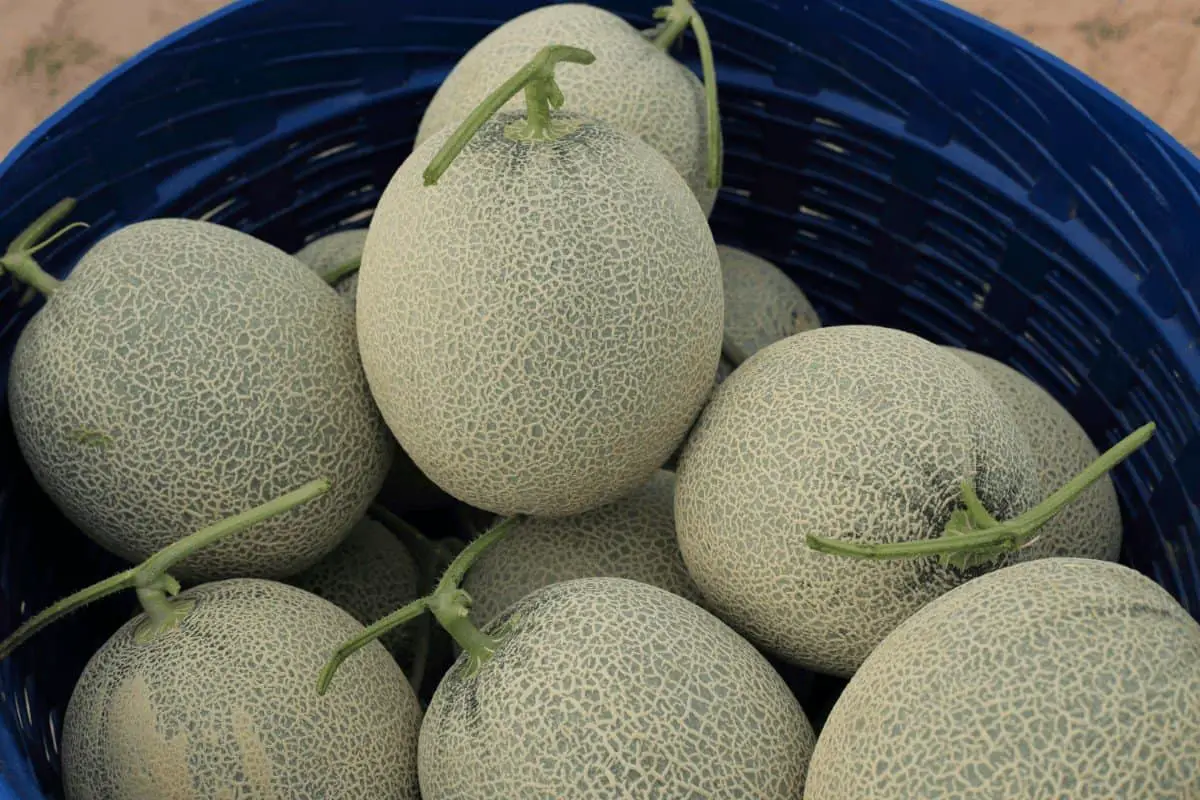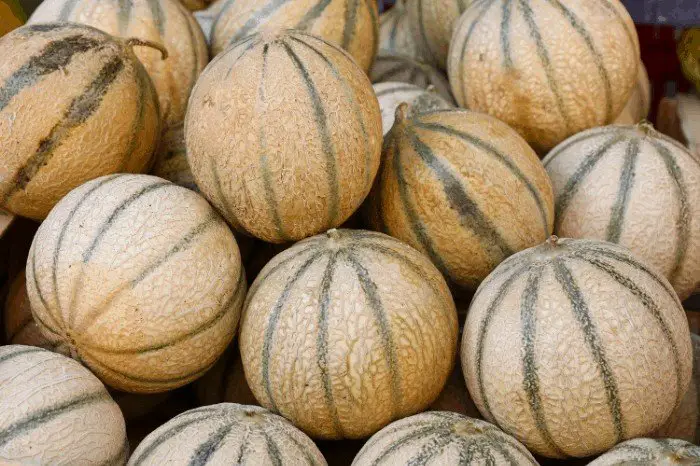Last Updated on December 28, 2021 by
When to harvest cantaloupe? Cantaloupes are delicious and you can only savor their taste if you harvest them rightly. Once they’ve been picked, they can no longer continue to ripen and you’ll be left with a fruit that’s hard and sour to your taste buds. Knowing when to pick cantaloupes from the vine can save you from this premature harvest and having a hard unripened cantaloupe. It is of sheer essence that you pick these cantaloupes when they are ripe for harvest to enjoy all of the tasty delights that they offer. If you pick them late after they’ve long ripened, you’ll have fruit too soft and watery for consumption and that could irritate your sensitive bowels if you have one.
So if you want to pick your cantaloupes but you are uncertain about their maturity, well the good news is that cantaloupes have green lights and clues that tell you to go ahead and pick them. All you need do is watch out for these signs which this article will reveal to you and then you can start picking. Without further ado, the following clues can help you know when to pick cantaloupes from the vine.
When To Harvest Cantaloupe- Factors To Consider
Study the Harvest Season
Typically, cantaloupes take anytime between 80 – 100 days to ripen after they’ve been planted. So you have to watch out for this harvest window as soon as you are done the planting. This can, however, differ from climate to climate. Most climates that are not favorable to melons can take a longer time to mature and ripen. Lower temperatures and extreme foggy conditions can delay the ripening process of cantaloupes. These conditions limit the viability of this timeline for harvest. If you want to continue with this method for knowing when to pick cantaloupes from the vine, then you have to study the weather conditions while keeping tabs on the calendar. There are maturity dates printed on the seed packet, they can serve as a guide to helping you harvest.
When To Harvest Cantaloupe: Color of the Melon
Almost all fruits tend to indicate how ripened they are with a change in their color. Their natural green tone changes slightly into yellow at their initial ripening stages. The yellow color becomes more pronounced as they ripen further without being picked. The same could be said of cantaloupes. The rind of the cantaloupe will appear yellowish or pale yellow away from its greyish-green initial color. You can also observe another indicator by lifting the fruit gently from the soil where the cantaloupe is using as a base and check the area for any color change. When the melon is ripe for harvest, this area, in particular, changes color first and indicates if fruit is ready for picking.
When To Harvest Cantaloupe: Ease of Harvesting
This ease of harvesting is common with most plants and the same rule applies here for cantaloupes. After all, indications have proved that the fruit is ripe for harvest, one more thing is left – the ease of picking. Unripened melon can resist picking because it’s hard but the ripened one is soft and makes harvesting seamless. That’s all the clue you’ll need. Even if it tries to be tricky with disguising in ripened colors, the ease or difficulty in harvesting would give it away and tell if truly it is ripe for harvest. It is essential to pick the fruit when you noticed some of these clues to avoid them going overly ripe. Most of the time, when they are mature and due for harvest, they can go off the vine on their own. If you meet them still glued with the vine, you can use a knife to cut them away.
Stem Slippage
Another change in the growing cycle of cantaloupes which is indicative of maturity is the slippage of the stem. Once maturity and ripening sets in, the stem will severe bonds with the melon. You can find out about this development if the stem turns brown and indicates a little cracking, then you raise the cantaloupe up gently and check if the stem has is now beginning to separate from its parent plant – the cantaloupe.
When To Harvest Cantaloupe: The Right Way to Pick Cantaloupe
When your cantaloupe is all ripened, picking can be a simple job and most times, the fruit separates itself from the vine easily and leaves you with a simpler job. However, some plants might prove to be very stubborn by resisting picking to a certain degree. If you are certain by all indications that the said cantaloupe is truly ripe for harvest, you can go ahead and pick it no matter the restraint it is displaying. But don’t force it out of the vine. Go easy on it, you could use a knife to cut it out gently. Forcing it out might injure the plant, damage the melon and subsequently leave the plant vulnerable to diseases. It can also lead to poor fruit quality. So tread with caution as you deal with resilient fruits.
Storage
After harvesting, storage is next if you don’t intend consuming all at once. Store in a refrigerator and you can have them last for up to a week while you enjoy away. A better way to store them is to skin off their rinds and the seeds after cutting into shapes, then refrigerate them like that. If you decide to use a melon-baller to cut them up, that will be excellent. And then if you want a prolonged storage time, placed the cut melons in a bag that will leave no room for the passage of air and put in the freezer, they could last up to 6 months under this storage condition.
Conclusion
Now that you are aware of the right time to pick your cantaloupes based on listed ripening indicative factors, it is also important that you note this: never water your cantaloupes a week before harvesting. Your calendar should help you with this. Remember it takes about 80-100 days after planting to be matured and ready for harvest. So monitor the harvest window and when it’s about a week to the ideal harvesting time, stop watering your plant. This will help the plant focus on the sugars and produce delicious melons for your consumption.
FAQs
How can you tell when a cantaloupe is ripe on the vine?
When the fruit is ripe, you can smell a sweet fragrance emanating from it.
Cantaloupes only ripen on the vine when they are picked. Ripe cantaloupes will be soft, but not too soft. It is important to check the cantaloupe’s stem for an indication of ripeness. If it comes off in your hand easily and there is no resistance, then that means that the fruit is ripe for picking and consumption.
Cantaloupes are harvested in the late summer and early fall when they are ripe. When you feel for a cantaloupe, it should be firm and heavy for its size. Cantaloupes also have a honeycomb pattern on the skin that is more pronounced when it's ripe.
How long does it take for cantaloupe to ripen after picking?
A cantaloupe is ripe when it has a good balance of sweetness and acidity. It usually takes between 10 and 16 days for a cantaloupe to ripen after picking, but the ripening period can be as short as four days or as long as 24. In general, the length of the cantaloupe ripening period is influenced by how hot it is outside during this time.
Once you pick a melon, if you store it at around 60 degrees Fahrenheit (16 degrees Celsius) in a place that has plenty of air circulation, then it should take about 10-16 days to fully ripen. If you live in an area where the temperature inside your home is much warmer than 60 degrees Fahrenheit (16 degrees Celsius), then expect your melon to take up longer to ripe.
How long does it take for a cantaloupe to ripen in a paper bag?
A cantaloupe takes 2-3 days to ripen after being picked.
In order for a cantaloupe to ripen faster, some people cut it open and leave it out on a plate.
The paper bag is the best option as the decaying of the ethylene gas will make the cantaloupe ripen faster. Ripe cantaloupes will turn orange-yellow and soft to the touch. The process takes up to 3 days in a paper bag at room temperature.
Will cantaloupe ripen off the vine?
The answer is yes. The fruit will ripen when it reaches its mature stage and not before that.
Cantaloupe tends to be ripe during summertime, which means that eventually all fruits will fall off of their vines - not just melons like cantaloupe but also watermelons, pumpkins, and other fruits that tend to grow in warmer climates.
What can you do with unripe cantaloupe?
Unripe cantaloupe can be used for making a refreshing iced tea. You can also use it to make a fun, colorful summertime drink.
Most people are familiar with the popular drink that is made from unripe cantaloupe and fresh lemon juice, but have you ever thought of what else you can do with this fruit?
Unripe cantaloupe, or rather a raw one, can be used for some creative purposes. The skin of the fruit is soft enough to allow for painting and other crafts activities. It can also be used as a substitute for glue in some crafts where it is not possible to use glue.
Unripe cantaloupe is also recommended to use as an effective tool in creating paper flowers and other small crafts projects.
Tony Manhart is a passionate gardener who has been tending to gardens for over 20 years. He takes pride in creating beautiful outdoor spaces with plants, trees, and shrubs that can thrive in any environment. He loves to share his knowledge with others and has taught classes on gardening basics and advanced techniques. He is committed to sustainability, using natural and organic methods to create and maintain gardens. He also works with local organizations to create green spaces for communities. When he’s not gardening, Tony enjoys hiking, reading, and spending time with his family.


